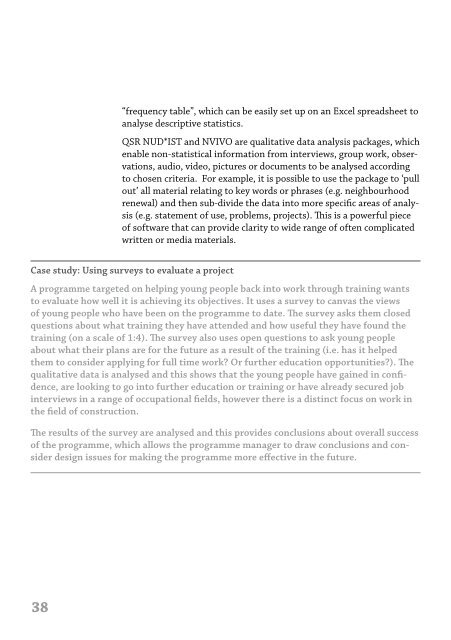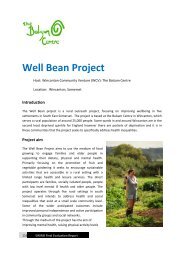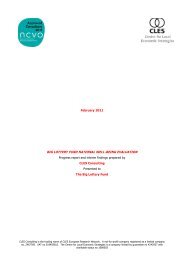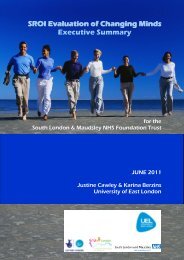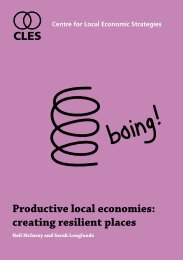Research Methods Handbook.pdf - CLES
Research Methods Handbook.pdf - CLES
Research Methods Handbook.pdf - CLES
You also want an ePaper? Increase the reach of your titles
YUMPU automatically turns print PDFs into web optimized ePapers that Google loves.
“frequency table”, which can be easily set up on an Excel spreadsheet toanalyse descriptive statistics.QSR NUD*IST and NVIVO are qualitative data analysis packages, whichenable non-statistical information from interviews, group work, observations,audio, video, pictures or documents to be analysed accordingto chosen criteria. For example, it is possible to use the package to ‘pullout’ all material relating to key words or phrases (e.g. neighbourhoodrenewal) and then sub-divide the data into more specific areas of analysis(e.g. statement of use, problems, projects). This is a powerful pieceof software that can provide clarity to wide range of often complicatedwritten or media materials.Case study: Using surveys to evaluate a projectA programme targeted on helping young people back into work through training wantsto evaluate how well it is achieving its objectives. It uses a survey to canvas the viewsof young people who have been on the programme to date. The survey asks them closedquestions about what training they have attended and how useful they have found thetraining (on a scale of 1:4). The survey also uses open questions to ask young peopleabout what their plans are for the future as a result of the training (i.e. has it helpedthem to consider applying for full time work? Or further education opportunities?). Thequalitative data is analysed and this shows that the young people have gained in confidence,are looking to go into further education or training or have already secured jobinterviews in a range of occupational fields, however there is a distinct focus on work inthe field of construction.The results of the survey are analysed and this provides conclusions about overall successof the programme, which allows the programme manager to draw conclusions and considerdesign issues for making the programme more effective in the future.InterviewsFurther ReadingSee Question Bank for details of question design -http://qb.soc.surrey.ac.uk/Computer Assisted Qualitative Data Analysis (CAQDA) –http://caqdas.soc.surrey.ac.uk/ - provides practical support, trainingand information in the use of a range of software programs designedto assist qualitative data analysis. Also provides various platforms fordebate concerning the methodological and epistemological issues arisingfrom the use of such software packages.<strong>Research</strong> Observatory, University of the West of England -http://ro.uwe.ac.uk/RenderPages/RenderHomePage.aspx - the site isdivided into topic areas with each topic area containing a number oflearning units and a collection of resources about a particular subjectrelated to research.What is the method?One of the most popular and frequently used methods of gatheringinformation from people about anything is by interviewing them. It isalso the most popular method used within the social sciences. There isa continuum of formality around interviewing and it covers a multitudeof techniques, from informal “chats” maybe arranged as “vox-pops”right through to highly structured, formal interviews, taped and transcribed.The different types and styles of interview elicit very different types ofinformation. Conducting interviews is an interpersonal process andas an investigator you must be very aware of your own behaviours andassumptions in the context. Interviews are not “neutral” social spacesand you must be respectful and maintain appropriate boundaries at alltimes.What do I need to consider?Interviews are a qualitative method of research often used to obtainthe interviewees’ perceptions and attitudes to the issues. The key issue38 39


